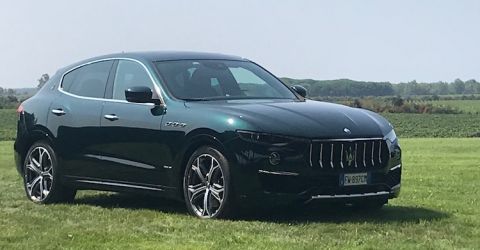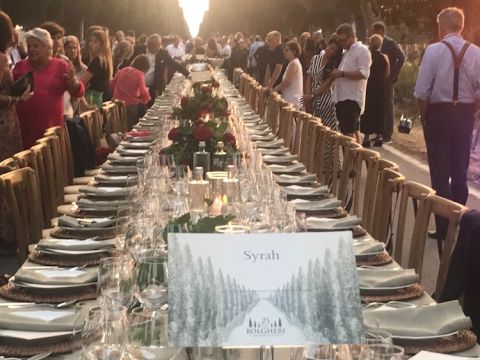‘There is no plan B.’ With evening rain forecast, this was a constant, worried refrain in Bolgheri, the Tuscan coast’s smartest wine region by far, on the last day of August. The wine producers’ ambitious plan was to serve a dinner for 720 to celebrate the quarter-century since the Bolgheri appellation was created. But not just any dinner, an outdoor one along the world-famous Viale dei Cipressi, the avenue of ancient cypresses leading up from the Roman Via Aurelia coast road to the hilltop village that gives the appellation its name.
Most Italian appellations, called DOCs, are very much older than this, but there are all sorts of other ways in which Bolgheri DOC differs from the Italian mainstream. The principal one, and the one responsible for the planned dinner, is that there is an unusual degree of harmony and co-operation between the producers. The many wine professionals whom I met during the day of the dinner agreed that such an initiative, backed by all 56 members of the Bolgheri Consorzio of wine producers, would be completely impossible in most other Italian wine regions. Too many warring factions. Too many self-serving agendas. Too great a contrast between the most and least successful of the producers.
One commentator suggested that one reason was that the district is dominated by two ancient Florentine families, the Antinori and the Frescobaldi – who communicate well socially, while being commercial rivals. Once both of them agreed to the dinner plan, inspired by the fact that the Consorzio uses the cypresses as its symbol, then everyone else fell into line.
Another major way in which Bolgheri differs from most other famous Italian DOCs is that it is centred not on indigenous grape varieties, but on French ones, those used for red bordeaux. This makes the area of less interest to those fanatical about Italy’s unique viticultural heritage, but of considerable interest to the foreign investors who have poured in since the seminal wine, Sassicaia, proved its worth and in the 1980s started to command the same sort of price as a top red bordeaux. Cabernet-based Sassicaia started out as the house wine of the Marchese Incisa della Rocchetta, a close relative of the Antinori who were the first to commercialise it, in the mid 1970s. Sassicaia 1985 is one of the world’s most famous wines.
In the 1990s, the 2000s, and even today, outside investors have been drawn to Bolgheri like bees to a rather glamorous honey pot. The Antinori may have deep roots here but it didn’t take long for others to join them. Angelo Gaja, the most famous wine producer in Italy’s famous wine region Piemonte, bought his Ca’Marcanda estate in Bolgheri in 1996. The Allegrini family of fine Valpolicella fame arrived in 2002. Dozens of others, many without a history of wine production elsewhere, own estates here, some tiny.
The Frescobaldi took control in 2005 of the Ornellaia estate established as a personal enterprise by Marchese Lodovico Antinori in the mid 1980s. (A quarter is owned by the Russians who make Moskovskaya vodka.) In the last few years investors have come to Bolgheri from Ireland, Russia, Argentina and Austria. One must assume that the main attraction here is the potential of the land to produce luscious ripostes to red bordeaux – but it is difficult to ignore the sparkling Tyrrhenian sea visible from so many of the vineyards, with sandy beaches lined by a dense green canopy of umbrella pines (pini marittimi). Elba and, often, Corsica beckon in the distance.
Bolgheri represents one of the few nexuses between fine Italian and fine French wine. Nowadays the Antinoris’ Cabernet-based Solaia and the Frescobaldis’ rich Merlot, Masseto, form an important part of the smart non-French wines just launched on the Bordeaux Place. (The merchants of Bordeaux, under pressure from falling interest in Bordeaux en primeur futures, have turned eagerly to a roster of ambitiously-priced foreign wines and now release them early every September to supplement their income from the baby bordeaux that has long been put on sale before each year’s summer holidays.)
The Antinori estate, once called Belvedere and now called Guado al Tasso, is the dominant one, accounting for almost a third of the 1,370 ha (3,385 acres) of vineyards in the appellation (about the same as the Bordeaux appellation of Pauillac with its three first growths). The Antinori entered fully into the spirit of those weekend celebrations, having done a deal with Maserati so that we guests almost stumbled over them. The Maserati above was parked outside the main house and, we were told, customised by Albiera Antinori. An increasingly dusty fleet of them was employed to ferry 60 of us from the original Guado al Tasso homestead to a site deep in the woods where the Antinori raise Cinta Senese pigs. Here they entertained us to a picnic lunch at one long table – though not nearly as long as the 300 m of long tables needed for that night’s planned dinner.
The cicadas were out in force, but were not loud enough to drown out many a sinister thunderclap during lunch. ‘There is no Plan B’, Albiera Antinori confided, frowning skywards, sitting across from me, wicker picnic basket between us packed with a pork hamburger and passata di pomidoro.
In the event, Bolgheri had no need of a Plan B. The evening was balmy. The guests from all over Italy and beyond were well-marshalled and in their seats by eight when a four-course meal of surprising quality was deftly served from two tented kitchens by Guido Guidi Ricevimenti of Florence. The many bottles poured were determined by table, many hosted by the major producers.
Each table was named for a grape variety and I was rather surprised to see tables called both Sauvignon Blanc and Syrah (above, seen as everyone milled around while the sun set), neither varieties readily associated with Bolgheri. Admittedly Ornellaia has long grown Sauvignon Blanc, chiefly because of Lodovico Antinori’s personal affection for it rather than because the warmth of the Tuscan coast readily suggests itself as the perfect milieu for this crisp, aromatic wine. Ornellaia Bianco tastes rather more like a Napa Valley Sauvignon Blanc than one from Marlborough or Sancerre. Bolgheri white wine eggs are currently being put in the fashionable Vermentino basket, but it is red wine for which Bolgheri is really famous.
The district, like so many, is seeing hotter and drier summers and an increasing number of producers are turning to one particular red wine grape to help them deal with this. Early-ripening Merlot, even the cossetted vines of Masseto, suffers particularly – despite the useful cooling sea breezes that can be depended upon in Bolgheri’s best sites. Cabernet Sauvignon can too easily taste a bit stodgy after a very hot summer. Fragrant Cabernet Franc is the current darling of many top producers. And the territory is so warm that is can sustain a varietal version rather than having to blend it with other red bordeaux varieties (see some worthwhile examples below). But be warned: Bolgheri wine is never cheap.
Varietal Cabernet Francs on the Tuscan coast
Bolgheri
Guado al Tasso, Matarocchio
Il Macchiole, Paleo
Poggio al Tesoro, W Dedicato a Walter
Argentiera, Ventaglio (yet to be released)
Costa Toscana just north of Bolgheri
DueMani
And, for the first time, some Cabernet Franc is being planted on the Masseto estate to freshen up the Merlot.

















